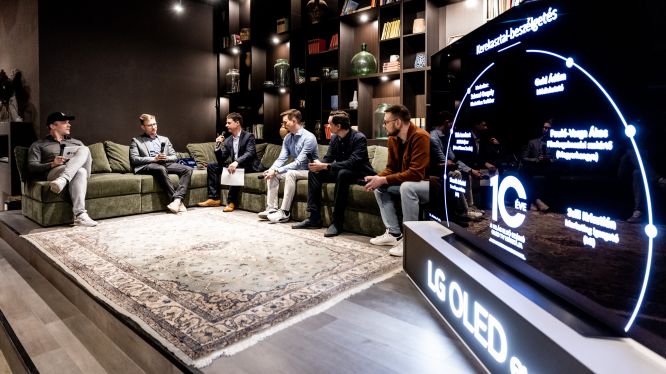TECH NEWS – According to experts, in the last decade, the development of smart TV systems and display technology, as well as the rise of streaming platforms, represented the biggest change in both home screen use and the cinema industry, while cinema-sized displays and the further spread of artificial intelligence are the trends of the near future. , and the availability of adequate mobile bandwidth for cloud-based video games that can be played anywhere.
“A few years ago, people had to be persuaded to buy a smart TV, because the only thing consumers knew about it was that it ran YouTube. It has now become fundamental that we watch not only linear broadcasts on TV, but increasingly different streaming platforms as well” – shared his experiences at the round table discussion held on the occasion of the 10th anniversary of LG OLED Dániel Slezsák, the LG expert. “Compared to this, in the last two or three years, we have come to the conclusion that one of the most important considerations for customers when purchasing a television is the streaming services offered on the given device,” Krisztián Szili added. >, marketing manager of LG Hungary.
Ádám Guld, a media researcher, sees the most profound change in the quantity and quality of various displays in everyday life, from TVs and monitors to smartphones to smartwatches. “We are now surrounded by screens everywhere, through which we consume a wide variety of content. The latest research shows that the representatives of Generation Z, who are considered trendsetters in terms of communication, spend approx. 80 percent of them are spent in front of some kind of screen, a large part of it is consuming content, and the other large part is playing some kind of game,” said the expert.
“The streaming boom clearly had the biggest impact on the cinema market” – opined Ákos Paulo-Varga, film journalist and film distribution expert. He sees that the cinema is thanking him in a sense, it’s good that, for example, the second part of Avatar or Top Gun: Maverick were also interested in people here. However, it is not yet clear what kind of solution or answer cinemas dealing with auteur and art films can offer to the very strong competition posed by streaming technology and the home screens available today (including OLED TVs and monitors). This is a challenge not only from the point of view that for the price of one or two cinema tickets you can practically buy a monthly subscription, but also from the point of view of how people can be lured away from the TV and back to the cinema.
The TV is no longer the hearth of the family
“The role of television has been reevaluated, as even in the 1980s researchers compared the TV to the fireplace around which the family gathers,” Ádám Guld pointed out. The latest research already shows that the user culture has changed: everyone in the household watches their own screens separately, but there are those special moments – for example, watching a match or a movie together – when the TV can still use this social function to fill. In addition, media consumption is increasingly becoming one of the most important forms of leisure activity or relaxation for the entire generational palette, so it is not surprising that people are much more willing to spend on solutions that provide a higher experience. This is also confirmed by the fact that in many cases this – that is, television – is the only or almost exclusive means of entertainment, which is why relatively larger sums are spent on it even in lower income social groups.
According to Tóth Lambert, the game designer of Primal Game Studio, players also sacrifice for displays, which is why the importance of consoles in the screen market is outstanding. The explanation for this is that when a new-generation console is launched, it brings with it the need to replace the screen, as consumers want the best possible gaming experience and to experience the atmosphere as fully as possible. “Furthermore, the fact that the average price of OLED TVs, which were practically unaffordable for the majority at the time of launch, has essentially halved in 10 years has also had a positive impact on the video game development side, as the technology is now available to smaller studios as well” – added Tóth Lambert. This has the advantage that games can be developed directly for it, so they can also meet the needs of gamers who play on OLED TVs or monitors.
What can the future bring?
According to Tóth Lambert, two things can have a huge impact on the game industry in the near future. On the one hand, if the bandwidth of the mobile internet reaches the level at which it is possible to stream games from the cloud from anywhere, moreover, a game mixed with virtual reality, that is, the servers will carry out the necessary enormous computing work. The other could be artificial intelligence, which could work in the content production side, and all of this could bring a huge breakthrough in the gaming industry.
Ákos Pauló-Varga believes that one of the answers to the challenge of reaching viewers in the case of auteur films is probably to reshape the presentation of the works into a community event with emphasis on the community experience. “As for the technological aspect, medium and in the long term, it is also conceivable that, instead of traditional screening, cinemas equipped with larger OLED screens will show these films in smaller rooms than usual” – said the expert.
“From a technical point of view, I see that we can currently meet all demands in terms of image quality with OLED technology, so I expect a stronger development in terms of size. In addition, the available software and services also form a complete whole, but innovation is also continuous here, and the variety of functions that a home TV or monitor can fulfill is changing dynamically” – opined Dániel Slezsák.
Source: LG press release















Leave a Reply